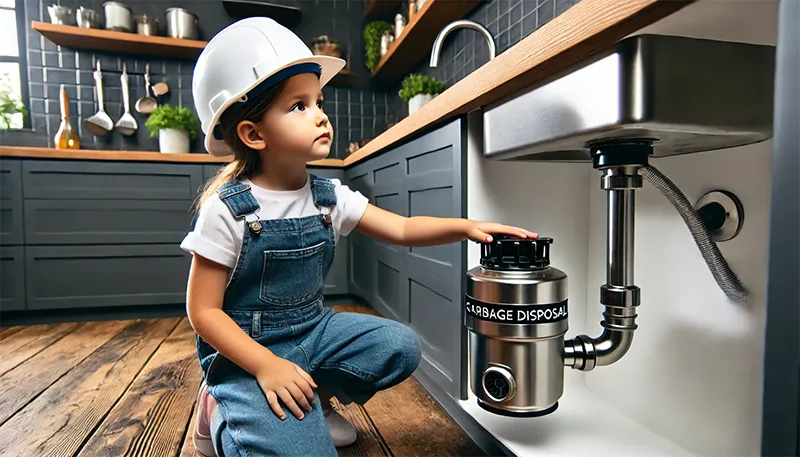Did you know that over 50% of American homes rely on garbage disposals for efficient waste management Choosing the right type of garbage disposal can make kitchen cleanup faster, safer, and more efficient.
With so many options available, selecting the perfect disposal can feel overwhelming. In this guide, we break down the 5 best types of garbage disposals to help you find the one that best suits your needs and lifestyle.
Continuous Feed Garbage Disposals
Continuous feed garbage disposals are the most common type found in modern kitchens. These disposals run as long as the switch is on, allowing you to add waste continuously while the motor operates.
Pros:
- Convenient for Large Cleanups: Perfect for getting rid of large amounts of waste quickly.
- Easy to Use: Just turn it on, and it works non-stop.
Cons:
- Safety Concerns: The open design can pose a risk, especially for children.
- Water Usage: Requires running water while operating, leading to higher water consumption.
Best For: Busy households that generate a lot of food waste and need a quick, continuous cleanup solution.
Batch Feed Garbage Disposals
Batch feed disposals only work when the cover is securely in place. Waste is processed in batches rather than continuously.
Pros:
- Safety First: The cover prevents accidents by ensuring the unit only operates when securely closed.
- Controlled Use: Ideal for smaller, controlled amounts of waste.
Cons:
- Slower Operation: Not ideal for large quantities of waste.
- Higher Cost: Slightly more expensive due to added safety features.
Best For: Families with children or households where safety is a primary concern.
Compact Garbage Disposals
Compact garbage disposals are designed for smaller kitchens, apartments, or RVs. These units fit easily into tight spaces under the sink.
Pros:
- Space-Saving: Perfect for kitchens with limited cabinet space.
- Energy Efficient: Uses less power for smaller waste loads.
Cons:
- Limited Capacity: Not suitable for large families or heavy use.
- Lower Power: May struggle with tougher food waste.
Best For: Apartments, condos, RVs, and small kitchens where space is at a premium.
High-Speed Garbage Disposals
High-speed garbage disposals feature powerful motors with RPMs typically exceeding 2,500 revolutions per minute. This speed helps grind waste faster and more efficiently.
Pros:
- Quick Grinding: Reduces the risk of clogs by grinding waste rapidly.
- Handles Tough Waste: Can break down harder materials like bones and fibrous food.
Cons:
- Noisier Operation: Faster motors can be louder.
- Energy Consumption: Uses more electricity compared to lower-speed models.
Best For: Households that produce significant amounts of waste and need fast, efficient grinding.
Eco-Friendly Garbage Disposals
Eco-friendly garbage disposals are designed to minimize water and energy use while providing efficient waste management. Some models even integrate composting features.
Pros:
- Lower Utility Costs: Reduces water and electricity consumption.
- Environmentally Friendly: Supports sustainable waste management practices.
Cons:
- Higher Price Tag: Advanced features can make these models more expensive.
- Limited Availability: Fewer options on the market compared to traditional disposals.
Best For: Eco-conscious households looking to reduce their environmental footprint.
How to Choose the Best Garbage Disposal for Your Needs
When selecting the best garbage disposal for your home, consider these key factors:
- Kitchen Size: Compact models for small spaces, larger units for spacious kitchens.
- Usage Needs: Continuous feed for frequent use; batch feed for safety.
- Budget: Balance between affordability and advanced features.
- Noise Levels: Look for models with sound insulation if noise is a concern.
- Motor Power: Higher horsepower for heavy-duty use; lower power for light use.
Maintenance Tips:
- Run cold water during and after use to prevent clogs.
- Avoid disposing of fibrous materials and grease.
- Regularly clean with baking soda and vinegar to eliminate odors.
FAQs
-
What is the difference between continuous and batch feed garbage disposals?
Continuous feed disposals operate while you run water and the switch is on, whereas batch feed models only work when the cover is securely in place.
-
Are garbage disposals safe for septic systems?
Yes, but it’s essential to use models designed specifically for septic systems to avoid damage.
-
How long do garbage disposals last?
With proper maintenance, most garbage disposals last between 8-15 years.
-
What is the quietest type of garbage disposal?
Models with sound insulation technology and lower RPM motors tend to be the quietest.
-
Do garbage disposals use a lot of electricity?
No, garbage disposals are energy-efficient, typically costing less than $1 per year to operate.
Which one is Best Types of Garbage Disposals?
Choosing the right type of garbage disposal can make a big difference in your kitchen’s efficiency and safety. Whether you need a continuous feed for convenience, a batch feed for safety, or an eco-friendly model for sustainability, there’s a disposal to meet your needs. Consider your household’s size, waste output, and safety requirements when making your decision.
Have a favorite garbage disposal type or brand? Share your tips and experiences on social media and help others make an informed choice!



